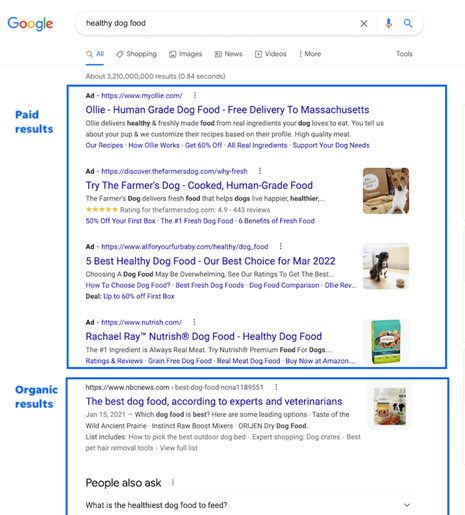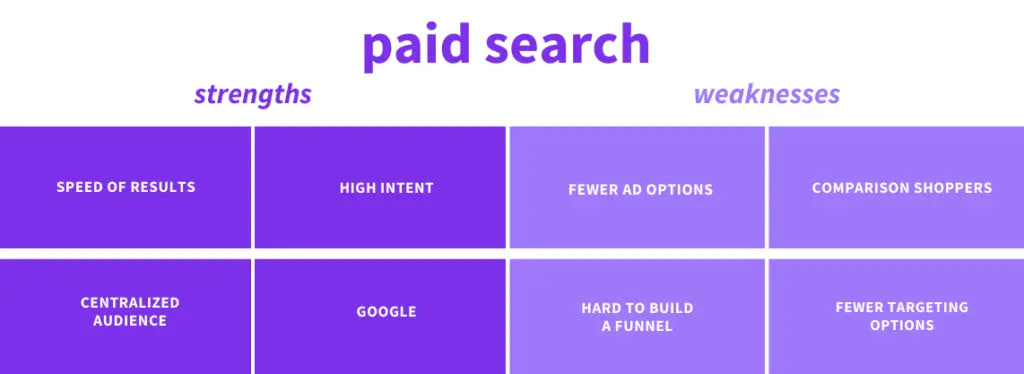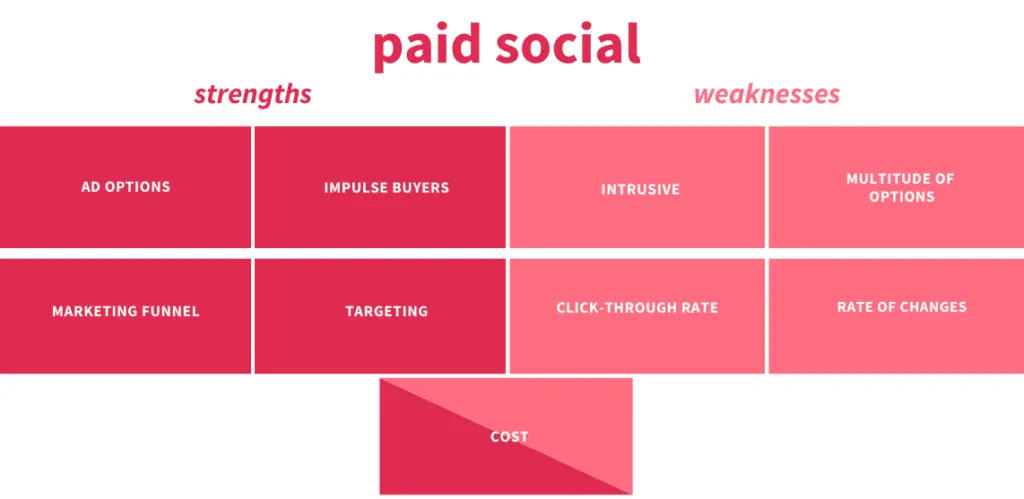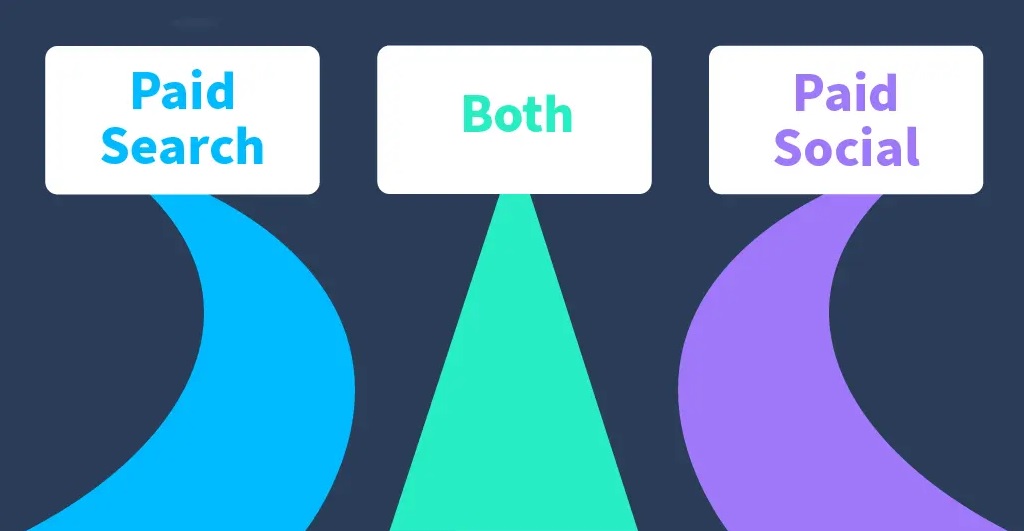Depending on the brand’s purpose, marketers and managers have many options to create an effective campaign. Paid Search and Paid Social stand out as two forms that bring many advantages. Join Marketing AI to learn about the concepts and analyze the strengths and weaknesses of these two forms. At the same time, bring Marketers ways to choose and use them effectively to include in the campaign!
What is Paid Search?
Concept
Paid Search is a form of Advertising in which businesses pay search engines to buy advertising positions on website results (usually on Google, Bing, Coc Coc …). This is part of SEM (Search Engine Marketing). Paid Search can be advertising for each click (PPC – Pay per click) displayed above natural search results (Organic Search) (Google Adwords is the most popular Pay-Per-Click advertising platform.). When users type keywords or keyword phrases on search platforms like Google, results from Paid Search will be displayed first as illustrated below:

If you own a dog food Brand and use Google Ads in your advertising campaign. Then the ads will be bid to appear on the page results (search queries) when users search for keywords. Advertisers will only have to pay when users click on the ads. As illustrated above, the Paid Search results will appear above, before the Organic Results.
Additionally, paid search advertising includes:
- Shopping ads can contain images, product names, prices, and brand names.
- Google Local Services Ads are specifically for service businesses.
Included payment types:
- Pay per click advertising (PPC) like the example above
- Pay when ads are shown (Cost per thousand impressions CPM)
- Pay when a phone call is made
With 93% of online experiences starting from search engines, Paid Search is a great way to advertise your brand to users. Because when users type in keywords (according to their needs), the first results displayed will always attract them to click to learn more.
Advantages & Disadvantages of Paid Search
| STT | Advantage | Disadvantages |
|---|---|---|
| 1 |
Fast customer reach speed: According to the keywords that customers are searching for, paid search campaigns often gain a large number of people to reach and be interested quickly. Because the results will be prioritized to be displayed at the top of each search platform. |
Advertising format: Most search ads are text-based. There are also product listing ads and display ads, but basically, Paid Search’s ad format choices are not very diverse and Creative. |
| 2 |
High purchase intent: Customers actively search on platforms when they really have a need for the product. Paying to have your ad appear first among the returned results will make it easier for customers to decide to click and continue their shopping journey. |
Compare user search results: With online searches, users will have many choices of products/services. When the results are displayed, they can easily compare your products and competitors, thereby increasing the competitiveness. |
| 3 |
User Object: Google’s market share among search engine platforms is 86.6% which means most users are on one platform. You focus on conquering one platform to be more effective. |
Longer marketing funnel: People in the early stages of the shopping journey, that is, when they just have a need and start looking for product information to consider their choice, the shopping process from Paid Search will be longer. |
| 4 |
Google Ads (formerly Google Adwords), Google’s paid search advertising platformAt the same time, Google also provides many self-study tutorials and online courses so you can learn and implement them for your campaigns. |
How to target a limited audience: Paid search offers some basic audience targeting options, such as demographics (age, gender, geographic location, etc.), but not as diverse as Social Media advertising’s targeting options (interests, behaviors, habits, etc.). |

Advantages and Disadvantages of Paid Search
With Paid Search, the metrics you need to track for your campaign include:
- Average cost per click
- Average click-through rate
- Average cost per lead
- Average Conversion Rate
What is Paid Social?
Concept
Paid Social is a form of online advertising that businesses have to pay on social media platforms such as Facebook, Instagram, LinkedIn, TikTok, Twitter and Pinterest (and other platforms) to display ads to the target audience. With this strategy, Marketers will pay to advertise their brand to reach more users (branding) or to collect leads (performance) and many other purposes on social media.
Vietnam currently has 72.7 million social network users, accounting for 73.3% (according to DataReportal report January 2024)). Some popular social networks include Facebook, Youtube, Zalo, Instagram, TikTok. Social networks have been playing an important role in the lives of many different age groups, as a place for entertainment, information search and online shopping. Businesses that make good use of social networking platforms will increase their ability to reach potential customers and expand their brand.
Paid social often proactively brings brand product messages to users, even when they have no intention of searching or buying the product. Meanwhile, paid search can only display information when users actively search for products or services.
b. Advantages & Disadvantages of Paid Social
| STT | Advantage | Disadvantages |
|---|---|---|
| 1 |
Various forms of advertising: On each social media platform, there are many rich advertising options and images, from images, stories, reels, carousels, videos to engaging interactive experiences (minigames, contests…) |
With a variety of advertising formats, the pace of change is also rapid: Social networks are always changing with new trends being updated. Therefore, you need to monitor changes in algorithms on the platforms to adjust your advertising strategy. |
| 2 |
Marketing Funnel: Paid Social can work together in many different forms to lead users from unknown to loyal followers and to brand advocates (purchase decisions). |
Click Through Rate (CTR): Social media platforms that want users to stay longer need to be really good and engaging to retain users. If the ads are lackluster, the click-through rate (CTR) will be extremely low. |
| 3 |
How to target: Social media platforms (like Facebook) collect information about target audiences clearly and specifically, such as age (18-24, 25-35…), interests, habits, access time and demographics. |
Annoying to users: When ads appear while scrolling through the newsfeed, users feel like they are wasting time and being interrupted. This will make them annoyed and may turn off or block the ads. |
| 4 |
Buying on impulse: Users surf social media and make purchasing decisions based on emotions or crowd psychology. Applying psychological knowledge in communication campaigns also brings unexpected results. |
Expense: Paid social media advertising typically has a fairly low average CPC (cost per click). But cheap impressions don’t necessarily translate to good conversion rates. So running ads is expensive and wasteful. |

Advantages and disadvantages of Paid Social
How to use Paid Social and Paid Search for Optimal Results?
Before choosing Paid Social or Paid Search in a communication campaign, the brand needs to determine specific business goals. Paid Social is suitable for the goal of enhancing brand and product awareness by reaching the target audience directly and specifically, according to clear user behavior. With the goal of boosting Sales, Paid Search is considered a potential solution. The brand captures the keywords and keyword phrases that users are searching for and have available needs. In some campaigns, it’s ideal for Marketers to combine both: Search engine advertising and social media. It’s a way to engage your target audience wherever they are on their buying journey.
Besides, depending on the brand’s budget, marketers can “tailor” a suitable solution.The industry also has a big impact on the way of advertising. Creative industries that need to be expressed visually through images and videos such as fashion, architecture, cuisine, travel, etc. will be more suitable for Paid Social instead of choosing Paid Search.

Marketers should choose paid search or social search
Conclusion:
Both Paid Social and Paid Search have their own advantages and are essential advertising methods that make up a comprehensive marketing strategy. By understanding their strengths and combining them with different business objectives, brands can create effective strategies that are in line with their budgets, reach the right audience, and ensure engagement and conversion. Regardless of which paid advertising method a business chooses to invest in, the effectiveness will depend on the continuous analysis and optimization of the brand’s campaign.
Comment Policy: We truly value your comments and appreciate the time you take to share your thoughts and feedback with us.
Note: Comments that are identified as spam or purely promotional will be removed.
To enhance your commenting experience, consider creating a Gravatar account. By adding an avatar and using the same e-mail here, your comments will feature a unique and recognizable avatar, making it easier for other members to identify you.
Please use a valid e-mail address so you can receive notifications when your comments receive replies.
